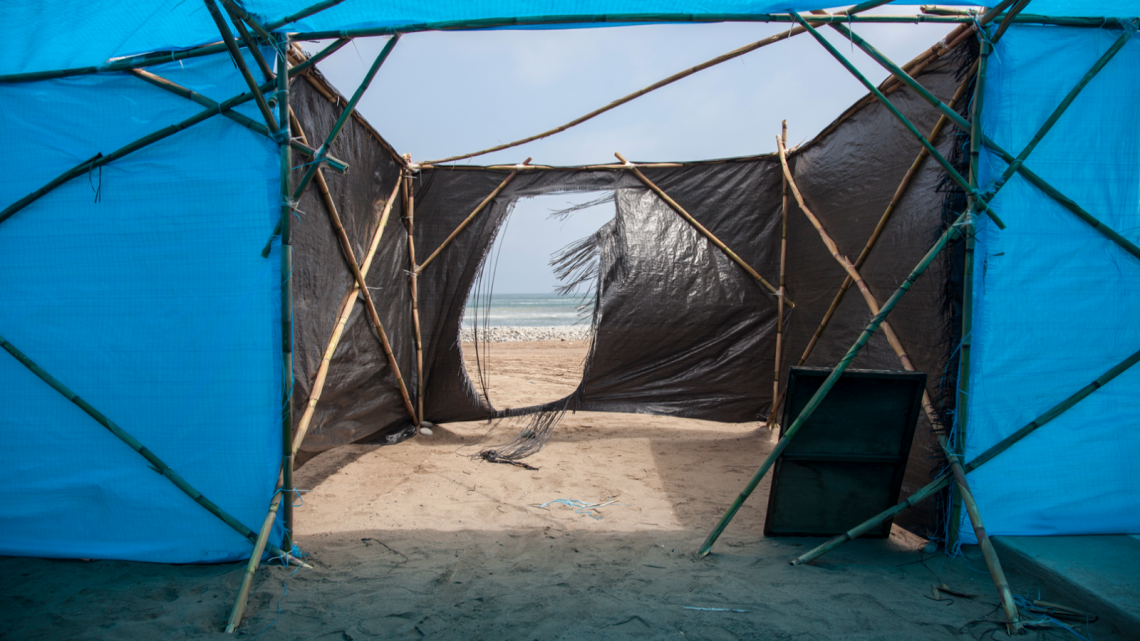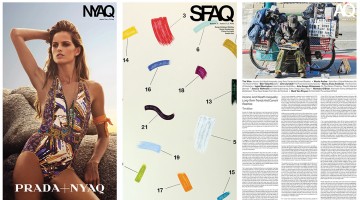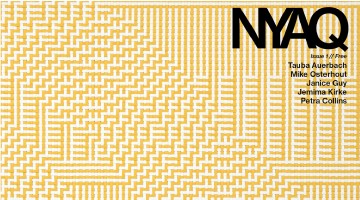The 21st century begins with an abrupt return to space. After the long extended flight of the modern era, globalization itself was preached and practiced as a metaphor for flight and liquidity, and the new world of multiculturalism heralded the beginning of a new world order. The Towers of Babylon of absolute space rose in defiance of human scale, us not having had enough time to catch up and accommodate our sensory organs to this new order of perception; our sense of places entered the Copernican dynamics, once our old places became too large to be lived in. We began to simply transit through places, rather than inhabit them. This new space is not a square or even a dot: morphologically, the space operates as a multidirectional vacuum that, rather than grounding, continues expanding endlessly, reproducing social space cyclically. To be sure, this new space is no longer a combination of sites in their particularity, but a field of simultaneity.
What happened to time, then? It is not that it disappeared, but the conflation of time-space that made the edifice of metaphysics collapse curved space in such a way that it acquiesced with the temporal once time became the topography and currency of the modern world, losing its experiential value. The process is far more complex: the obsession with history in the 19th and 20th centuries had to do less with the dissolution of national states and more with the political history of time themed around cycles, progress, crises, and an ever accumulating past. While modernity is always a project of the future—like salvation—the realities of colonial domination throughout Earth made it an imperative to root the civilizational argument for imperialism in the fulfillment and achievement of a remote past as a destination. The aesthetics of Romanticism are only an early symptom of this program, which culminated in totalitarian expansion in the 20th century. With the unavoidable collapse of the European colonial project, new socio-economic realities emerged that uniquely shaped the degree to which time receded from the public domain with its political history, in order to open up a neutral emplacement.
Latin America is a particularly interesting case for cultural practitioners (artists, architects, theoreticians) because the early independence of the nascent states, in the early 19th century, meant that not only did they become independent long before the end of the colonial era, but they also inherited the intellectual apparatus of historicism and imperialism, well engineered into the state. Despite significant advantages and none of the cultural and ethnic heterogeneities of South Asia, Africa, and the Middle East (the civilizational project had been very successful in both exterminating the native population and spreading the religion and language of the motherland), the region remained at an impasse with a chronic lack of infrastructure, industry developed only slowly, political strife has been as constant as the dependency on foreign aid, which has come in recent decades, hand in hand, with both armed conflict and economic boom. Strangely enough, unlike the Middle East, Latin America did experience the different phases of modernity, while still remaining particularly insular and subject to the politics of the new empires, although in its innovative form, without a civilizational argument, and exclusively at the service of corporatism.
It is precisely because of this complex heritage that Latin America has carved out for itself a place in the history of art, not only through the modern period: in the face of evidence of the contemporary’s depletion, an endless supply of modernist work from the most diverse enclaves, particularly those in conflict, has begun to emerge, but Latin America had been already long established. Contemporary art and its predecessors, the avant-gardes and their countless strategies for contestation, were present in Latin America at the time of their inception in the West, but as the art market morphed into global aesthetics, the strategies became of questionable relevance. How do artists from Latin America respond to the challenge of new (economic) geographies, attempt to challenge third-worldism, and speak the international artspeak of the contemporary?
When Peruvian artist Santiago Roose (b. 1974) returned to his native Lima after a decade in Europe, he went through a year of re-adaptation and re-cognition of his native city; a journal of writings, sketches, drawings, and photography: “The root of the matter is that there was this whole talk about constant progress, growth, and a lot of blahblahblah. The first image, in comparison with what there was before, was exactly that; there was a visible face to this progress. However, this visible face of progress in Latin America is a facade, a kind of wall of shame behind which everything is the same or much worse.” Trained in photography and design, Roose chooses to not simply articulate a discourse but to enter through interventions between the visual and the material, a “polysemy of critical contents that could overlap, juxtapose, and combine into a more complex symbolic structure.” Whenever we hear about photography in the context of the third world, one thinks often of the fetishism associated with images of misery from peripheral and endangered tropes. Roose, however, takes on a sculptural path, often interwoven with other practices.
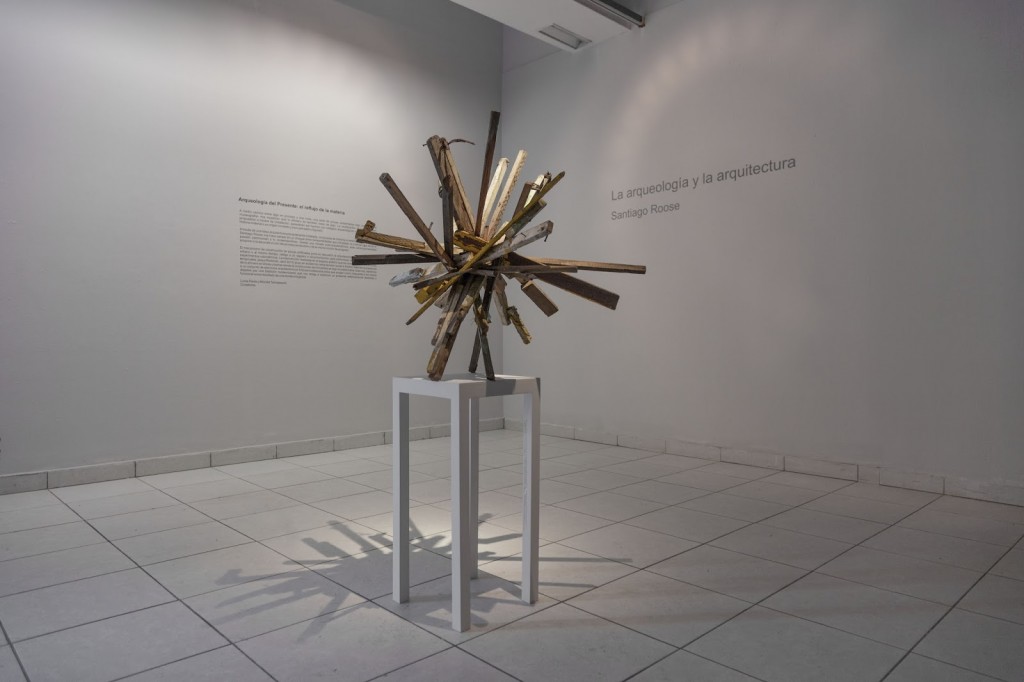
Asterisco (Asterisk), 2012, wood, dimensions variable. Courtesy of Galeria 80m2 Livia Benavides, Lima, Peru.
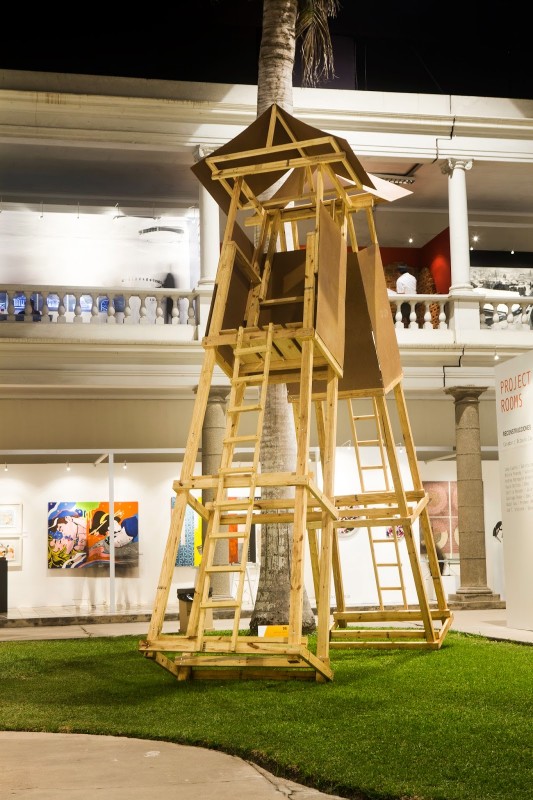
Sistema de frontera (Boundary System,) 2014, 570 x 550 x 150 cm. Presented at the Art Lima 2014 Project Room. Courtesy of Galeria 80m2 Livia Benavides, Lima, Peru.
In one of his most recent works, Sistema de frontera (Boundary System, 2014) presented at the art fair Art Lima 2014 Projects Room, he displayed two functional structures (in this case, a watchtower, which often occurs in his work) that have stepped back from their function into a system of equilibrium with each other that is not only eminently sculptural but also annuls functionality in such a way that they become “two frozen bodies in continuous action.” In his work, Roose wants to distance himself from the ornamental nature of architectural interventions in contemporary art and proposes a critical architectural discourse for public art, in which the structures become analogous symbols for social structures and, above all, conflict.
The artist stabilizes his works in a discourse about art that does not favor the exploitation of a symbolic order of consumerism in order to advance a political program that is governed solely by economic interest.
Similarly, returning to the watchtower, in Sistema teoreticamente estable (Theoretically Stable System, 2013) shown at Art Basel Miami Beach 2013 Public Sector, a public art sculpture cum temporary installation, Roose simulates the fragile fabric of contemporary society through two temporary structures, closely tied with surveillance and the current obsession with security on the local and geopolitical level: the watchtower and the dog house. According to the artist, architecture operates under ethnographic semiology; it is purely descriptive. In these structures, the crass object and the material emerge as a sort of urban monument that requires a process of excavation through an experimental archaeology that will reveal not the found object, but the internal dynamics of the engineered object. The object is not a relic of the past, but a catalog of the moment, which displays social relations as a function of the structure, rather than the other way around. The emphasis on temporal structures is not necessarily a metaphor for precarity as much as an indicator of how the temporary has solidified into a condition.
Across the world, people living in transitory mega-cities, temporary high rises not suited to survive natural disasters, internment camps for refugees and the displaced, rings of misery around cities and dangerous hinterlands, are more numerous than those living in organic cities with running water, electricity, and transportation grids. After the Industrial Age lies in ruins (think about the car factories in Detroit, now one of America’s most violent cities, or the structures of brutalist architecture from England to Sweden to Brazil, now either derelict or gentrified), the solid modernity of aluminum and steel which begot the postwar world becomes a distant antiquity whose language of progress and civilization is more and more foreign to a world in which only tiny islets of security remain in the third world. It is surrounded by complex security schemes, planted as a quicksand in a world no longer at war and apparently less poor than any other period in human history, but also the most unequal and violent of all possible worlds. The fact that we perceive such a world to be the most violent perhaps has more to do with how much exposure we have today to images thereof.
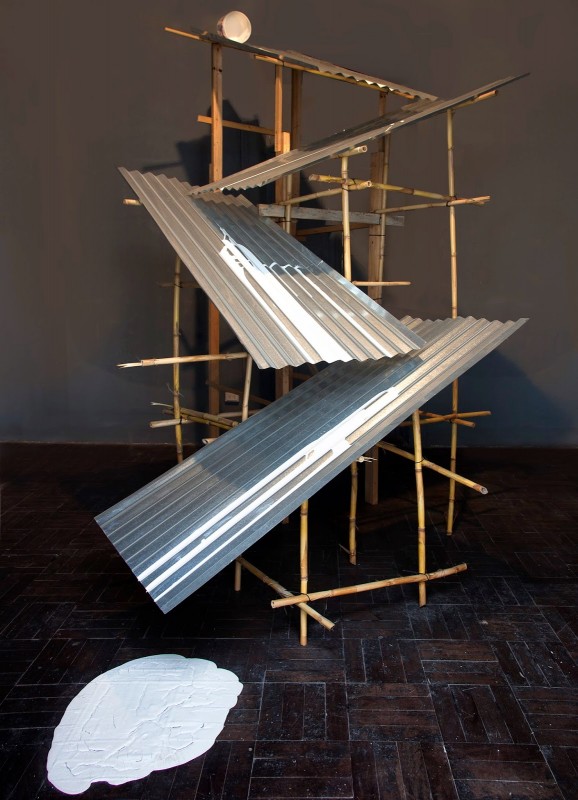
Prototipo de accidente (Accident prototype), 2013, 360 x 420 x 350 cm, wood, cane, corrugated roofing sheets, paint. Courtesy of Galeria 80m2 Livia Benavides, Lima, Peru.
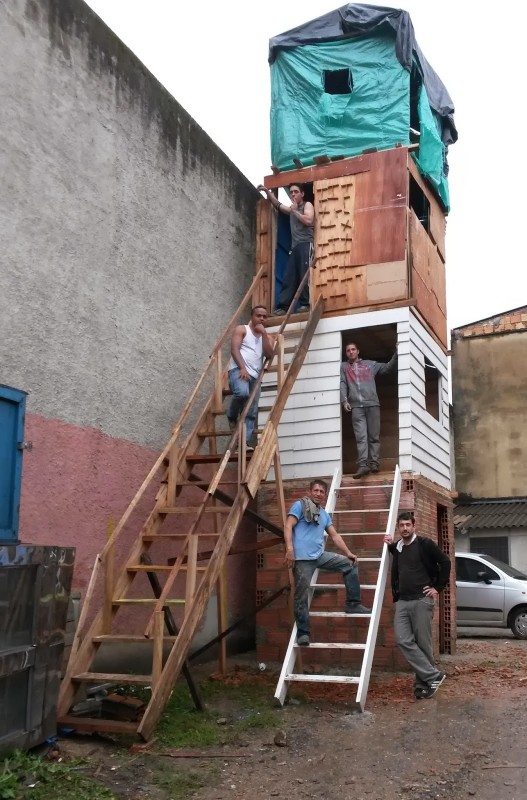
Torre (Tower), 2011-2013, mixed media, 600 x 200 x 800 cm. Courtesy of Galeria 80m2 Livia Benavides, Lima, Peru.
Certain critics of modernity insist that there was never a “modernity,” or at least that whatever it is, it’s not “qualitatively” different from antiquity. The problem with this view is that, while eliminating a good number of dichotomies, it doesn’t offer an alternative to a world in crisis; it is also perhaps true that crisis is the only dynamic under which the modern can function and produce economic growth. In one of his most celebrated structures, Torre (Tower, executed first in Lima in 2011 and then at La Otra, Bogotá’s biennial in 2013), he elaborates on the symbolic language of power present in the periphery of cities and the instability of buildings in the rings of misery: “This piece is a criticism of urban modernism, but also of the hierarchy of social classes, the crowding in the peripheries, the indifference. The work is made of four floors in the form of block dwellings that grow into a tower. Each one comes with its own stairway, and they get poorer and poorer as you climb up them.” There is something frightening about entering this structure, built with local found materials, for the ground seems to crumble under you as you climb up.
It is, however, two larger projects, Determinaciones socioterritoriales (Social-Territorial Determinations, 2012–2013) and Maloka (2012), where Santiago Roose deploys the fuller extent of his critical architecture, for they are conceived as real-size structures that, albeit temporary, provide a ground for social architecture and for a surrogate public space whose abolition throughout the developing world and transformation into memory-less spaces of consumerism has remained a constant. “The project along the coast was a type of huaca (the name given to all the pre-Columbian shrines laying in ruins throughout the country). It was fabricated with the most precarious materials used to build slum dwellings. From this duality a number of possible interpretations emerge which I prefer to leave open. The piece was some one hundred meters long and was perfectly visible from different points of the coast of Lima and right in front of the commercial bay and touristic zone. I should also mention that it took place during the time when the two new art fairs had just opened in the midst of the World Economic Forum.”
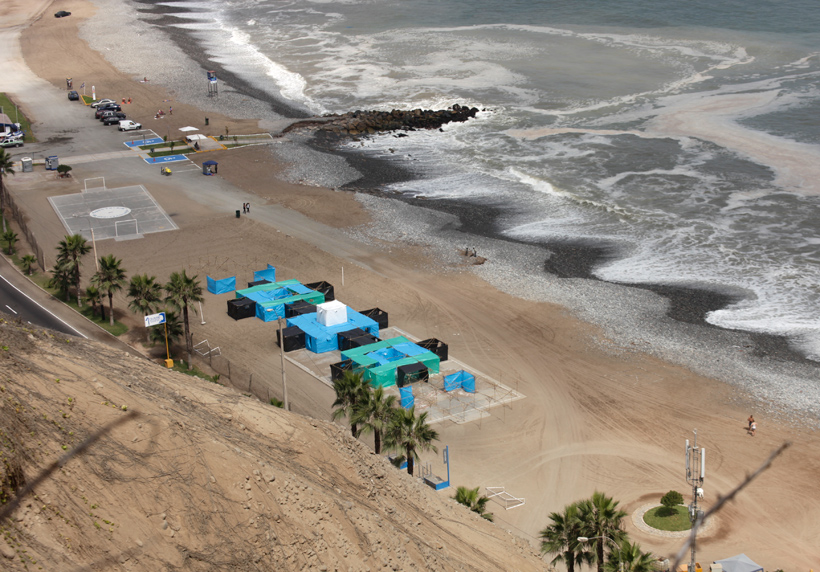
Colonia litoral 1 & 2, (Coast Colony), intervention on a public beach in Lima, 2013. Courtesy of Galeria 80m2 Livia Benavides, Lima, Peru.
Roose also developed a similar project in Burkina Faso using a different structure with a similar function, but, rather than the performative element of transporting the materials and constructing it on site, it acquired a truly social dimension: “The piece in Africa was an experiment in social architecture. A live structure which responded to immediate needs that were brought up in the process of assembling it. An exercise on adaptation in every level. First it responded to the basic need of shadow from the reckless sun, and gradually it turned into a welfare center, sometimes a bar, etc., depending on the moment of the day. It is the work with the utmost social resonance I’ve done so far, for the people in the neighborhood helped me put it up but then they completely adopted it as their own. I ended up going there merely as a guest.” These practices, however, shouldn’t go without scrutiny. What does one make of architecture and the context of social exclusion in the contemporary art world of fairs, biennials, big money behind art institutions, and the elite sport of collecting objects of misery?
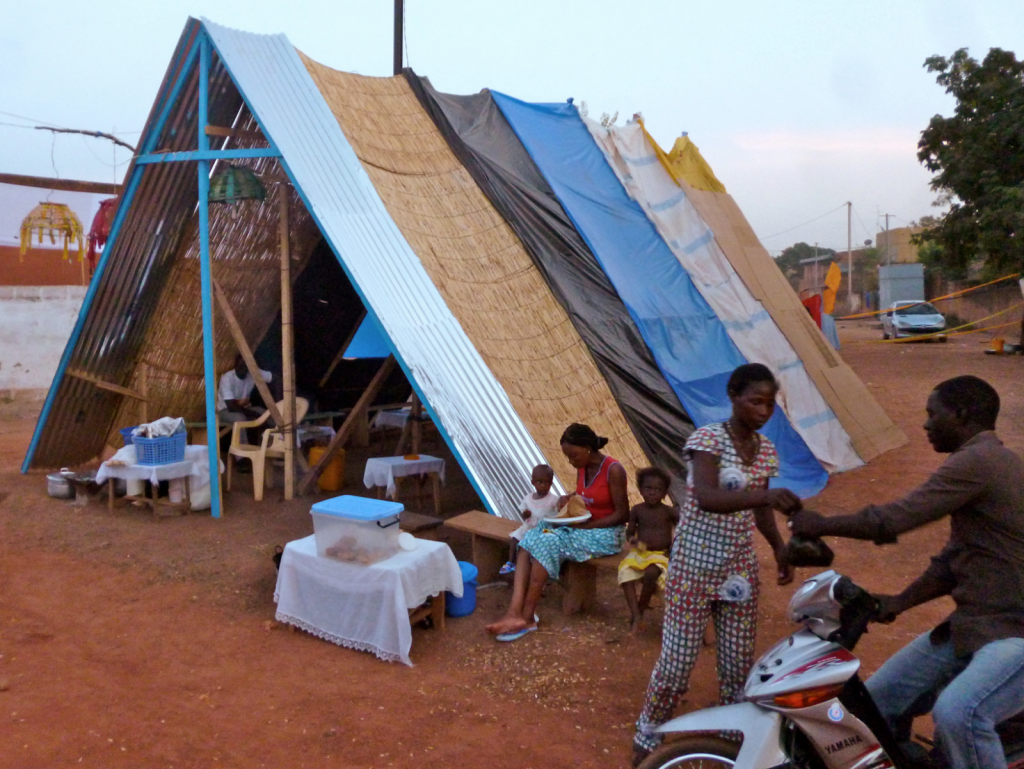
Maloka, 2012, intervention in the popular neighborhood of Bougsemtenga, Ouagadougou, Burkina Faso. Courtesy of Galeria 80m2 Livia Benavides, Lima, Peru.
The artist expands on the topic of contemporary artists from Latin America (and other regions as well) bringing the misery of the third world without irony into the luxury halls of fairs and biennials: “Latin America, from a contemporary art viewpoint, is a kind of catalogue of fashionable objects that speak of our miseries. Objects in the broadest sense of the word. I have this feeling since I assumed myself as contemporary artist that it is necessary to be global in order to be ‘good,’ as if globalization was a necessary step not to fine-tune one’s discourse or broaden the scope of action, but to fall within the fashion of standardization imposed by the fairs and the curators. But for a ‘peripheral’ artist, the ideal is not to establish his own specificity within the art world but to make his work exotic within the frameworks decided by the globalization of art. Chunks from the periphery are torn off and distributed throughout, from London to Hong Kong, pretending to offer a glimpse into what’s being done in Latin America. As Juan Javier Salazar points out, Latin American political art made out of situations that are both bloody and terrible is now in fashion.”
The notion of the barbarian is making a comeback, acquiring new layers of meaning that are related to both the geopolitical and the socioeconomic order. In the classical world, barbarian referred to the foreigner that did not speak Greek and was therefore thought of as uncivilized, ill-mannered, uneducated, and violent. This notion lived through the ages in a number of circumstances and at present is used when referring to the infamous violence of the Islamic State in Iraq and Syria; however, the circumstances of barbarism are never exceptional enough as to not be explainable through the dynamics of power and money. Exoticism and Orientalism (the same ideologies that constructed the third world, and architecturally planned it as a zone of randomness) are forms to exhibit oneself as a barbarian—to send across the message that the human condition is divided between north and south, and that the wars against the peoples of the south, however despicable and aimless, were unavoidable. And as Roose has eloquently argued, there is no global aesthetic other than the painful process through which difference is obliterated for the sake of order in a very turbulent world.
What happened, then, to globalization, and what’s its effect on the architectural structure of contemporary life? “The answer is contained in the question itself. Security is the new obsession of the civilized world. It has gradually replaced everything else, including happiness or modernity itself, for instance. Security is one of the world’s largest industries and this has caused an irreparable loss of the human dimension in global architecture. This is an enormous and constant exercise of power that has become blind to itself. The dimension of this economy is written in each folder of every architectural structure; everything is almost transparent. You could easily perceive how cold it is inside each of these flats. I’m personally more interested in what neither hides nor showcases. The old houses of the middle classes, the same houses that in Latin America are becoming globalized buildings, half by opportunism and half by imposition. But, how to make an eight-story building in a place where there’s no such a thing as number eight?”
We are at a moment when our experience of the world is less than that of a long life developing through time than that of a network that connects points and intersects with its own skin, as suggested by Michel Foucault. Network, rather than time or space, is the most apt metaphor for the situation in which we are living now. Transparency is a realm of obscurity in which there’s little direct access to experience or information, and everything is diluted in a gigantic cloud (another very apt metaphor nowadays). This situation of transition, of living in a world half virtual and half real, has immediate political consequences for the vast majority of the world who are not interconnected and who, despite receiving the images of a global world that is open and prosperous, cannot enter it. For them, the walls and the boundaries and the checkpoints and the watchtowers are very real. Santiago Roose’s work is a not-so-subtle reminder that while those structures that we see in the periphery of our cities seem temporary, they are the building blocks of a pseudo-global aesthetic, lurking from underneath a discourse of progress, which is based on privilege and, by definition, on exclusion.
In his book Spatial Aesthetics: Art, Place and the Everyday, Nikos Papastergiadis suggested that a new spatial aesthetic (which obviously favors grand scale) is characterized by the history of site-specific practices whose utopian drive limited its scope for action. But contemporary art, as in the case of Roose, is not merely relational aesthetics and redefines itself as both social project and aesthetic framework. Exhibiting a work of art is no longer simply an emplacement but also an engagement between place and perception. Accordingly, Papastergiadis concludes: “I would argue that art does participate in the political through its own internal process of extending the language of resistance and representation. When art challenges the boundaries by which we understand the aesthetics of the everyday, and combines this experience with a new understanding of connection to our surrounding world, then it could be argued to have expanded the sphere of politics.
